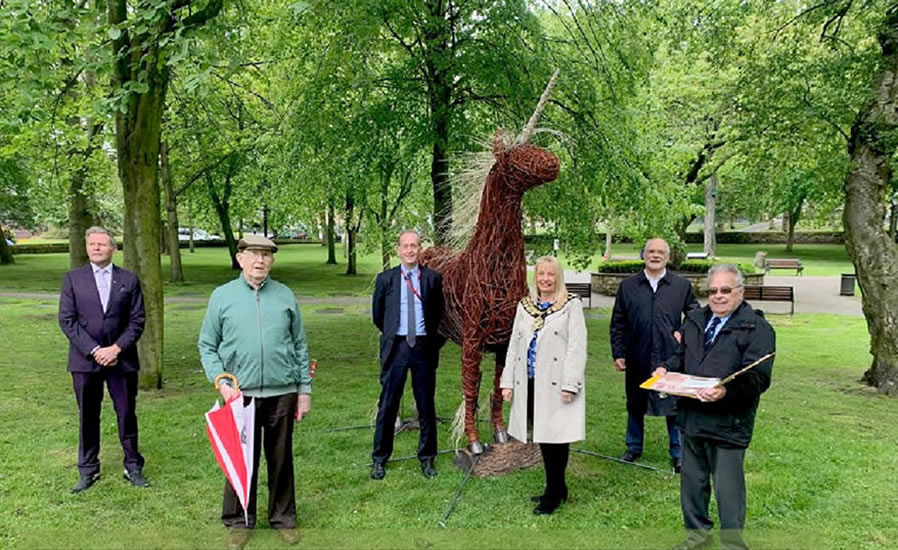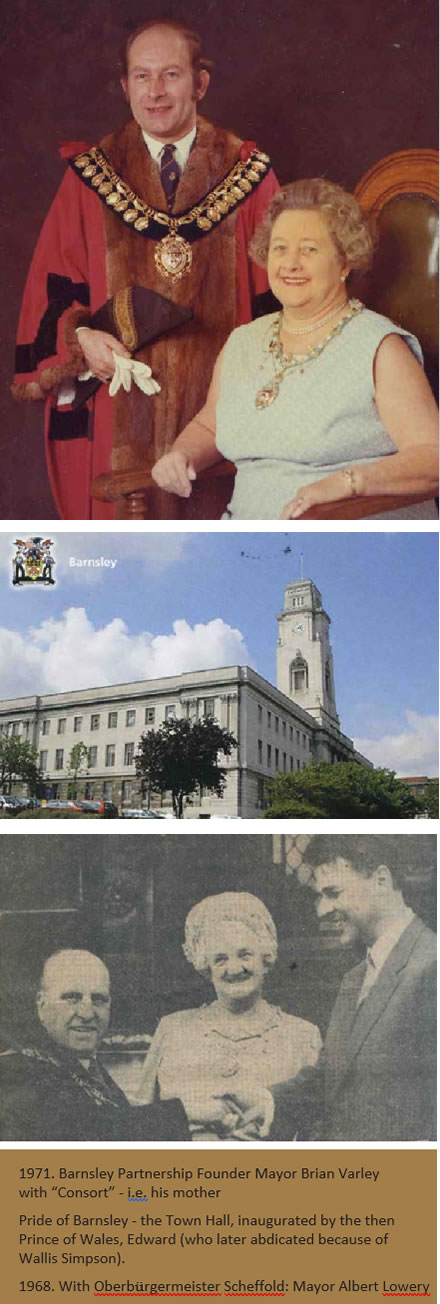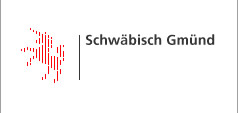News Archive
13/12/21...... for 50 Years of Town Twinning - Being there, experiencing it for yourself is everything!

A strong bond of friendship:
The Unicorn called Si-gmund (see Gmünd) on the occaision of the 50th anniversary of the twinning with Barnsley.
In the middle: Mayor Caroline Makinson; to her left Sir Steve Houghton, Council Leader,
then Keith Jowett (Hon. President of the Barnsley Twin Town Society) with umbrella in the colours of Gmünd,
and councillor Steve Green;
to her right: Phil Coppard, former Chief Executive of the council (Secretary of the Twin town Society)
and Peter Saxton (Vice-Chair of the Twin Town society)
Unicorn Si - gmund
Barnsley's symbol for 50 years of town twinning partnership
Being there - experiencing it for yourself is everything

With Grateful Thanks to
Professor. Dr. Reinhard Kuhnert. - Hon. President - Verein Städtepartnerschaft Gmünd
"The Schwaebish Gmuend Unicorn Publishers present their Unicorn Yearbook every year since 1974.
Whenever there were jubilees they asked me to write something about our town twinnings. We could not let this Golden Year pass by without another essay." Reinhard
Despite the Corona pandemic and the cancellation of all festivities, the friends from our northern English twin town Barnsley came up with a wonderful surprise:
For the 50th anniversary of the partnership, they put up the Gmünd
heraldic animal in the Churchfield garden in the town centre as a symbol of our strong bond.
Its particularly appropriate name is "Sigmund": in German one could translate “Come
and see Gmu(e)nd!
As in Germany the unicorn in England also stands for harmony and friendship, optimism and hope.
The German boy’s name Sigmund means “a victorious protector” for the next 50 years of friendship – despite Brexit.
When asked why one should get involved in town twinning, a Barnsley woman who had travelled to Gmünd with the association for the first time replied: “You have to be there; you have to have witnessed it to know why!”
On 24 June 1971, all parties formulated their expectations for this first Gmünd town twinning in the Gmünd town hall: “May the children of this marriage of cities be called friendship and understanding.” Both these expectations have become reality - this could and can still be experienced by anyone who wants to over these past 50 years.
On this day, the mayors of Gmünd and Barnsley, Dr Norbert Schoch and Brian Varley, signed the twinning agreement in front of the Gmünd municipal council. Brian Varley compared the twinning to a wedding: and so the children of this wedding shall be called friendship and understanding.
The topic of the wedding was further explored because the “Past Mayor” Frank Crow expected Gmünd and its Oberbürgermeister to find a suitable wife for Varley who was a bachelor. A wish that unfortunately did not come true, as Varley died suddenly soon afterwards.
The origins of this town twinning are very special.
Wales was the original destination to which some youthful pioneers set out in 1954 with Erika Beck, later Künzel, but they were stopped prematurely due to mad cow disease (BSE). A man from Barnsley “diverted” them to the mining town in South Yorkshire so that they would not have to break off their journey. They have never regretted this decision.
Later, Traute and Andreas Schmidt (director of the GD youth centre) maintained the contacts and in 1966 made the suggestion for a town twinning. In 1968 it seemed that the time had finally come when Mayor Hansludwig Scheffold travelled to Barnsley to set things in motion, but it was not until 1971 that the twinning became official.

The belief in Barnsley has always been that the twinning should be nurtured from within the community.
On the initiative of former mayor Arthur Williams, the English founded a twinning society in 1977 and called on the people of Gmünd to do the same. The foundation of a society in Gmünd was somewhat more bumpy but was finally achieved on 30. March 1982.
Town twinning needs external symbols for cohesion: these are a street name (on the Hardt/former US Housing Area), the famous “Red Telephone Box”, which was moved from Hintere Schmiedgasse to Grabenallee in 2019 and transformed into a book lending service, and the “Barnsley Garden” right next to it, which was created for the Federal State Garden Show in 2014 and has been lovingly tended by Dagi Glasenapp ever since.
How does a twinning visit work?
The Society Committees do the planning in cooperation with the respective officers from Barnsley and vice versa
Rituals or things that always have to happen
There must always be both a welcome and a farewell evening, as well as an official reception by the respective Mayor. This is usually celebrated musically by singing together the song of the “Swabian Railway” in English and the Barnsley Yorkshire hymn “On Ilkley Moor Baht’At”.
Staying with Families
All English/German guests stay with families and thus share their daily lives with each other. Almost every evening, other gatherings - so-called “parties” - take place in the private homes of members in Gmünd or Barnsley.
Here, the experience of the friendship between the cities becomes particularly tangible. Alternatively, hotel accommodation
can be arranged at own cost.
Experience the twin city and its culture Everyone witnesses the life, culture and changes in their twin city.
Getting to know the country and its people - trips to the surrounding area
The surrounding area with its characteristic cultural highlights also features in every twin town visit.
History
The two twin cities are actually as different as can be:
Barnsley is an industrial town, a former coal mining area with a population of about 90 000; Gmünd a traditional former Free Imperial Swabian town with "only" 60 000 inhabitants.
Barnsley is first mentioned in the "Domesday Book" (the definitive English land register) in 1086 and was granted market rights in 1249. The coal mining era began in 1624 and provided about 10,000 lifetime jobs for the inhabitants!
One of the worst mining disasters in the history of Great Britain Britain occurred on 12. December 1866: During a firedamp explosion at Oaks Colliery in the Stairfoot district 334 miners were killed. As a rescue team rushed to help, a second detonation occurred, killing another 27 people.
In the 1950s, coal mining began to decline, culminating in a strike from 1984 to 1985 that led to the end of mining. The last colliery closed in 1994.
Ever since, Barnsley has been struggling to implement structural change and experienced high youth unemployment. The recovery had been slow. By now, the old "concrete inner city" of the 1970s has disappeared and been replaced by modern buildings and new infrastructure.
Today, the Ardagh Glass Group is based in Barnsley and produces container glass for companies in the food industry from this site. Other main employers are the city administration and the health service.
There has been a lot of investment in education. The newly built Barnsley College runs the University Campus Barnsley in collaboration with several universities.
Famous Barnsley personalities
The famous Gmünd people are well known: Parler, Baldung, Rathgeb, Leutze etc. But in Barnsley?
A few should be mentioned. First and foremost is John Hudson Taylor, the founder of the China Inland Mission (whose German counterpart is the Liebenzeller Mission), for whom the city has specially signposted a “trail” or path to attract Chinese tourists.
Then there are the poets Donald Davie †1995 and Ian Macmillan (“the bard of Barnsley”), the novelist Barry Hines †2016 (his bestseller “Kes” became a successful film), the playwright John Arden †2012 (“Sergeant Musgrave’s Dance”) and Ashley Jackson, an important watercolour painter.
A Labour politician of national importance was Roy Lord Mason of Barnsley *1924 who became Secretary of State for Northern Ireland.
Conclusion after 50 years
In the fifty years since 1971, a tradition has been formed based on mutuality, respect and sympathy.
Town twinning is twinning people...... this guiding principle has proven its worth - especially after Brexit.
To Gmünd’s surprise, the vast majority of people in Barnsley voted for Britain to leave the European Union.
At the presentation of Si- Gmund, the Mayor of Barnsley, Caroline Makinson, affirmed the special quality of this partnership and assured that she had no doubt that it would last for the next 50 years and beyond.
However, "tradition does not mean managing the past but passing the torch on to the next generation", said Gmünd Chairperson Prof. Dr. Reinhard Kuhnert at the “Swabian birthday” celebrations.
The young generation has to be ready to get involved
In both twinning associations, the generational change has begun: the new chairs Dr Lukas Schachner and Alan Brentnall are both young and energetic, and stand for continuity, new beginnings and innovation.
Literature
Kuhnert, Reinhard. Die fünf Gmünder Städtepartnerschaften im Jubiläumsjahr 2016.
Einhornjahrbuch 2016. 131–142







